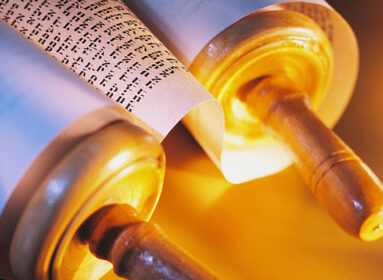By Shlomo Riskin
“(Bezalel) made two golden cherubs, hammering them out from the two ends of the cover (kapporet)… The cherubs had their wings outstretched upward so as to shield the ark-cover with their wings; they faced one another…”(Ex. 37:8-9).
So important and beloved was the sacred desert tabernacle that the Bible records both its construction and completion. For the Ramban (Nahmanides), the most important of the tabernacle furnishings was the Holy Ark repository of the Two Stone Tablets containing the Ten Commandments. The Ramban maintains that the prescription to build the tabernacle came immediately following the Revelation at Sinai; God’s voice continued to be transmitted between the two cherubs at the two ends of the ark-cover.
From this perspective, the symbolism of the “cherubs” is exquisite in its simple sensitivity. The Midrash (cited by Rashi on Ex. 25:18) explains that each cherub had the face of a babe with a body reminiscent of a soaring angel. If we are to accept the premise that God spoke through them, these figures who caringly directed their gaze towards each other are now represented by the greatest Torah scholars of each generation, whose wings transport God’s words from heaven to earth and whose whole-hearted purity is expressed in the purity of their faces. They transmit, interpret and “make relevant” the Divine words for every situation and generation. Responsa in each generation continue our opportunity to hear the voice of the living God.
But there remains one problem. The first time that the Bible mentions the word “cherubs” is soon after the creation of the world, when Adam and Eve were barred from the Garden of Eden: “(God) drove out the human being, and stationed the cherubs at the east of the Garden of Eden, along with the fire of the ever-turning sword, to guard the path to the tree of life. . .” (Gen. 3:24).
Here the cherubs appear to be negative creatures, holding the fire of the revolving swords in their hands, preventing the possibility of eternal life. Indeed Rashi (ad loc.) refers to them as “angels of destruction.” Why does the Bible use such destructive imagery for “cherubs” of the ark cover guarding the holy tablets?
Many years ago, when I was still a rabbi in Manhattan, I gave a sermon about the cherubic face of a young child; I suggested that children can either rise to exalted heights or descend to destructive depths, depending upon where they are stationed. Place them outside of the Garden of Eden with the fire of a revolving sword in their hands and you have messengers of destruction; place them next to the sacred ark and you have the cherubs between whom is heard the living words of the Divine!
Nevertheless, the problem of the usage of the term “cherubs” must be explained. How can the same term be so spiritually charged in the Book of Exodus when its initial usage in the Book of Genesis expressed destructiveness?
When I made aliyah, I saw Israeli soldiers stationed at every checkpoint and army base, and as the years went by my children and grandchildren were called up to serve. These young people often have the pure facial features of children (indeed, they seem to look younger and younger as I am getting older), and with Uzis in their hands, they too are protecting the Torah “tree of life” of our Jewish future. In our generation, the Torah must be protected in two ways: by scholars who guarantee its continuity by teaching and interpreting it, and by those who protect it in war from our enemies who seek to destroy it (and us). Both of these “cherubs” are sacred, deserving of our deepest gratitude.
This is the most blessed period for the Jewish people in the last 2,000 years. We have returned to our homeland after being “scattered to the ends of the heavens.” The Jewish exiles from across the world have miraculously returned home to Israel and the dry bones of Ezekiel have been granted skin, bones and flesh. Our “start-up” nation is succeeding on all fronts despite the constant strains and ravages of war.
However, as George Santayana taught, the only thing we learn from history is that we don’t learn from history. The propaganda spewed forth from the sick mind of Goebbels and his henchmen has morphed into the apartheid charges of the Arab and European nations; as the dysfunctional and disunited nations ceaselessly condemn Israel.
There is, however, one major difference between the 1930s and the year 2014: by grace of the Almighty, we now have a nation-state with military power. Lord Acton taught that power corrupts and absolute power corrupts absolutely, but nothing corrupts more than powerlessness. Powerlessness gives the victory to the forces of evil and darkness; to Amalek who targets civilians, who aims at the weak and the infirm, the women and the children. We Jews came into the world to see to it that compassionate righteousness and moral justice will trump brute force and jihadist strength. In our generation, we require the sacred cherubs with the fire of revolving sword in their hands to pave the way for the cherubs of the sacred ark in the Sanctuary of the Divine.
Rabbi Shlomo Riskin is chancellor of Ohr Torah Stone and chief rabbi of Efrat, Israel.








 Southern New England Jewish Ledger
Southern New England Jewish Ledger









